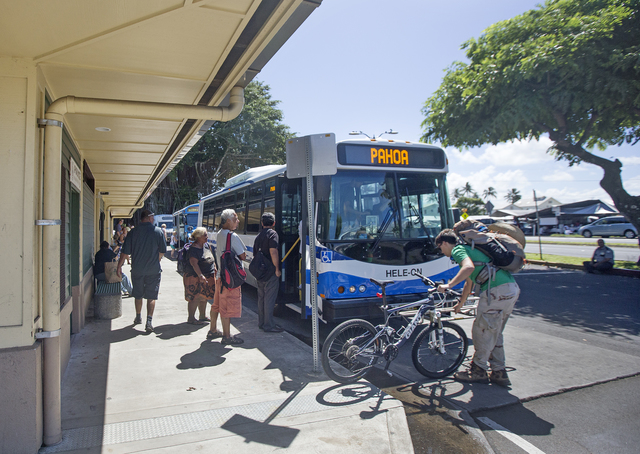Hawaii County’s vehicle fleet is a little bit more green thanks to a local partnership that increases use of biodiesel fuel. ADVERTISING Hawaii County’s vehicle fleet is a little bit more green thanks to a local partnership that increases use
Hawaii County’s vehicle fleet is a little bit more green thanks to a local partnership that increases use of biodiesel fuel.
It’s a small step toward a larger goal of reducing dependence on imported fuel sources while boosting local output of clean energy.
The county is now six months into a switch to a biodiesel blend called B20, which consists of 80 percent imported diesel and 20 percent locally made biodiesel. The latter is produced at the Pacific Biodiesel plant in Keaau.
County deputy managing director Randy Kurohara said in an email the shift was first considered in August 2013, when the county’s Research and Development Department began to look for new ways of reducing fossil-fuel dependence. Previous discussions on the matter had centered on reducing dependence in electricity production as opposed to transportation fuels, Kurohara said.
The county fleet of diesel vehicles consists of the Hele-On buses in addition to highway trucks and some off-road vehicles. Converting the fleet was also a recommendation of the county’s Energy Sustainability Program, which was released in 2012.
“It puts us in a great position to lead by example, and we have a facility here that actually produces high-quality biodiesel,” Kurohara said.
The Pacific Biodiesel plant in Keaau opened in 2012, and is capable not only of refining biodiesel but distilling it. The distillation capabilities mean that more types of waste products can be converted to fuel.
Biodiesel is made from waste products such as cooking or vegetable oils or animal greases. B20 operates using the existing diesel systems in vehicles.
“Nothing has changed in how we received the fuel,” said county mass transit administrator Tiffany Kai. “We have a fueling company that comes down to the county baseyard and the tank is there.”
“In the long run, we’re going to see the benefits,” Kai said.
The total amount of biodiesel the county will use in fiscal year 2016 is an estimated 1 million gallons. According to the Energy Sustainability Program, about $7.5 million annually is spent on fuel. Kurohara said the county was under budget for the current fiscal year.
Prices of B20 fluctuate with oil prices, since imported fuel is still needed to make the blend. The county contract for petroleum is held by Hawaii Petroleum and Aloha Petroleum.
“We can’t get to 100 percent renewables if we don’t start at 20 percent,” said Pacific Biodiesel vice-president Kelly King.
The county’s switch is the latest mass conversion to biodiesel. Hawaiian Electric Co. has used the fuel for the past eight years. The City and County of Honolulu switched its transportation fleet to biodiesel 10 years ago.
Honolulu’s switch was spurred by an effort to clean its landfills by keeping grease out of the premises. Trap grease and cooking oil from restaurants gets picked up by Pacific Biodiesel and transported to processing plants.
Ironically, Maui County, where Pacific Biodiesel was founded, has not made a switch, but King said Kauai County may soon begin using B20. The company is also working with the state Department of Transportation to switch its vehicles.
“It’s great because the more volume we have, the more we can start looking at where to build the next biodiesel plant in the state,” King said. “It’s really gratifying for us to be able to provide those kind of jobs.”
Email Ivy Ashe at iashe@hawaiitribune-herald.com.



